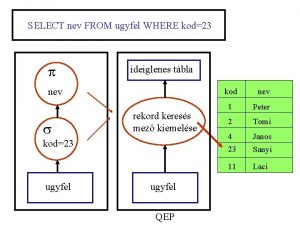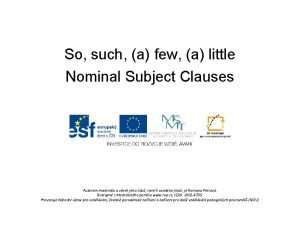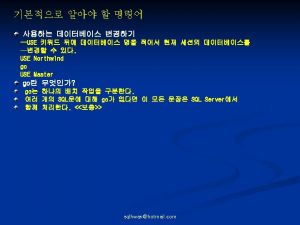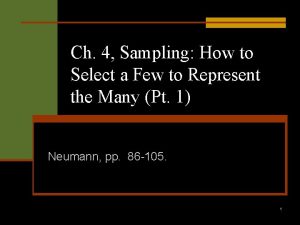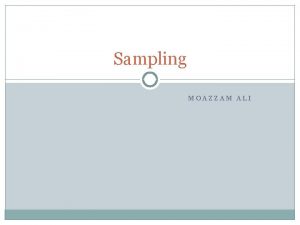Ch 4 Sampling How to Select a Few































- Slides: 31

Ch. 4, Sampling: How to Select a Few to Represent the Many (Pt. 1) Neumann, pp. 86 -105. 1

HOW AND WHY DO SAMPLES WORK? n A proper, representative sample lets you study features of the sample and produce highly accurate generalizations about the entire population 2

The most representative samples use random selection n The random process allows us to build on mathematical theories about probability n Due to their use of random selection, probability samples are also called random samples 3

Sample, population, random sample n sample: a small collection of units taken from a larger collection n population: a larger collection of units from which a sample is drawn n random sample: a sample drawn in which a random process is used to select units from a population 4

Sampling in qualitative research n Qual & quant researchers both use sampling, but qualitative researchers have different goals than to get a representative sample of a large population n Qualitative researchers believe a small collection of cases, units, or activities can illuminate key features of an area of social life n n Use sampling less to represent a population than to highlight informative cases, events, or actions Goal is to clarify and deepen understanding based on highlighted cases 5

FOCUSING ON A SPECIFIC GROUP: 4 TYPES OF NONRANDOM SAMPLES n Random samples are difficult to conduct n Researchers who cannot draw random samples use nonprobability sampling techniques n n Convenience sampling Quota sampling Purposive or judgmental sampling Snowball sampling 6

Convenience sampling n convenience sampling: a nonrandom sample in which you use a nonsystematic selection method that often produces samples very unlike the population it’s cheap and fast, but of limited use n with caution, can be used for preliminary phase of an exploratory study n n also called accidental or haphazard sampling 7

Quota sampling n quota sampling: nonrandom sample in which you use any means to fill preset categories that are characteristics of the population n Not as accurate as a random sample, but much easier and faster 8

Quota sampling: in steps 1) Identify several categories of people or units that reflect aspects of diversity in population you believe to be important -e. g. , gender or age 2) Decide how many units to get for each category, i. e. , what the “quota” will be 3) Select units by any method 9

Purposive or judgmental sampling n purposive sampling: a nonrandom sample in which you use many diverse means to select units that fit very specific characteristics n It’s like convenience sampling for a highly targeted, narrowly defined population n Used in 2 types of situations: 1) to select especially informative cases 2) to select cases from a specific but hard-toreach population 10

Snowball sampling n snowball sampling: a nonrandom sample in which selection is based on connections in a preexisiting network It is a multistage technique n Each person or case has a connection with the others n n also called network, chain-referral or reputational sampling 11

Examples of networks studied using snowball sampling n Scientists around world investigating same issue n Elites of a medium-sized city who consult with one another n Drug dealers & suppliers in a distribution network n People on a college campus who have had sexual relations with one another 12

COMING TO CONCLUSIONS ABOUT LARGE POPULATIONS n sampling element: a case or unit of analysis of the population that can be selected for a sample n e. g. , a person, a group, an organization, a written document or symbolic message, or a social action or event (e. g. , an arrest, a protest event, divorce, a kiss) 13

Universe, population, and target population – increasing degrees of specificity n universe: the broad group to whom you wish to generalize your theoretical results n e. g. , all people in FL n population: a collection of elements from which you draw a sample n e. g. , all adults in the Miami metro area n target population: the specific population that you used n e. g. , all adults who had a permanent address in Dade country, FL in Sept 2007, and who spoke English, Spanish, or Haitian Creole 14

Use target population to create a list of its sampling elements, a sampling frame n sampling frame: a specific list of sampling elements in the target population n population parameter: any characteristic of the entire population that you estimate from a sample n sampling ratio: the ratio of the sample size to the size of the target population 15

Why use random samples? n They’re most likely to produce a sample that truly represents the population n True random processes: 1) 2) are purely mechanical or mathematical without human involvement allow us to calculate the probability of outcomes with great precision 16

All samples contain a margin of error n A random process makes it possible to estimate mathematically the degree of match between sample and population, or sampling error n sampling error: the degree to which a sample deviates from a population 17

Key features of random samples 1) They’re based on an accurate sampling frame 2) They use a random selection process without subjective human decisions 3) They rarely use substitutions for sampling elements 18

Types of random samples n Simple random samples n Systematic sampling n Stratified sampling n Cluster sampling 19

Simple random samples n In simple random sampling: n n n First develop an accurate sampling frame Select elements from the frame based on a mathematically random selection procedure Locate the exact selected elements to be in your sample 20

Over many separate samples, the true population parameter is the most frequent result n sampling distribution: a plot of many random samples, with a sample characteristic across the bottom and the number of samples indicated along the side n The sampling distribution shows the same bell- shaped pattern whether your sample size is 1000 or 100 n but the more samples drawn, the clearer the pattern 21

Example of sampling distribution n Number of blue & white marbles that were randomly drawn from a jar of 5, 000 marbles with 100 drawn each time, repeated 130 times for 130 independent random samples Blue marbles White marbles # of samples 42 58 1 43 57 1 45 55 2 46 54 4 47 53 8 48 52 12 49 51 21 50 50 31 51 49 20 52 48 13 53 47 9 54 46 5 55 45 2 57 43 1

23

Systematic sampling n If you lack tools to select a pure random sample, systematic sampling is a quasirandom method n systematic sampling: an approximation to random sampling in which you select one in a certain number of sample elements; the number is from the sampling interval n sampling interval: the size of the sample frame over the sample size, used in systematic sampling to select units 24

Stratified sampling n Sometimes researchers want to include specific kinds of diversity in their sample, e. g. , racial diversity n stratified sampling: a type of random sampling in which a random sample is drawn from multiple sampling frames, each for a part of the population n Because you control the relative size of each stratum rather then letting random processes control it, you can be sure your sample will be representative of strata n Stratified sampling generally results in a slightly more representative sample than simple random sampling 25

Selecting a stratified sample 1) Divide population into subpopulations (strata) -To use this method, you must have info about strata in population (i. e. , the population parameter). 2) Create multiple sampling frames, one for each subpopulation 3) Draw random samples, one from each sampling frame 26

Cluster sampling n In some situations where there is no good sampling frame, you can use multiple-stage sampling with clusters n A cluster is grouping of the elements in the final sample that you are interested in n cluster sampling: a multistage sampling method in which clusters are randomly sampled, and then a random sample of elements is taken from sampled clusters 27

THREE SPECIALIZED SAMPLING SITUATIONS n Random-Digit Dialing (RDD) n Within-Household Sampling n Sampling Hidden Populations 28

Random-digit dialing n random-digit dialing: computer based random sampling of telephone numbers 29

Within-household sampling n A household can be thought of as a cluster in which there can be multiple sampling elements or individuals n To ensure random selection, create selection rules, and follow them consistently 30

Sampling hidden populations n hidden population: a group that is very difficult to locate and may not want to be found and is therefore difficult to sample 31
 Use of few a few the few
Use of few a few the few Litle a
Litle a Fill in a few a little
Fill in a few a little Complete the sentences using these words
Complete the sentences using these words Select * from select
Select * from select Select * from select
Select * from select Nameadmin
Nameadmin Select * from select
Select * from select Natural sampling vs flat top sampling
Natural sampling vs flat top sampling Contoh event sampling dan time sampling
Contoh event sampling dan time sampling A consumer confidence researcher asks several retailers
A consumer confidence researcher asks several retailers Stratified sampling vs cluster sampling
Stratified sampling vs cluster sampling Cluster sampling advantages and disadvantages
Cluster sampling advantages and disadvantages Meaning of sampling
Meaning of sampling Stratified random sampling vs cluster
Stratified random sampling vs cluster Bumblebee totem pole
Bumblebee totem pole Such a few
Such a few Rome is located on the peninsula of
Rome is located on the peninsula of These are a few of my favorite things poem
These are a few of my favorite things poem Concept paper examples
Concept paper examples Chapter 7 market structures
Chapter 7 market structures Metar few sct bkn ovc
Metar few sct bkn ovc Gafor gebiete
Gafor gebiete Which of the following few common services provided by os
Which of the following few common services provided by os Joyce the dead last paragraph
Joyce the dead last paragraph A little a few a lot of much many
A little a few a lot of much many 6 biomes and aquatic ecosystems answers
6 biomes and aquatic ecosystems answers The harvest is plentiful but the laborers are few meaning
The harvest is plentiful but the laborers are few meaning Maybe god wants us to meet a few wrong
Maybe god wants us to meet a few wrong Means of communication
Means of communication Lbm key
Lbm key Lines composed a few miles above tintern abbey
Lines composed a few miles above tintern abbey




